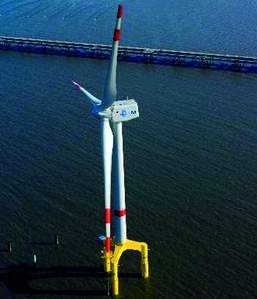German wind turbine manufacturer Bard Group has begun operation of the country’s first offshore turbine at Hooksiel, the forerunner of a much larger project off Borkum island in the North Sea.

While Germany has one of the largest onshore wind markets in Europe, and the greatest amount of installed capacity, it has yet to complete construction of a large-scale offshore project. But at the end of October German wind turbine manufacturer Bard Group began operation of the country’s first offshore turbine. The
5 MW produced at this pilot site will flow into the gas and electrical station in the coastal city of Wilhelmshaven. It is the company’s third wind turbine to be grid connected.
Bard has installed its 5 MW VM-type training and demonstration wind energy converter in the outer Jade Estuary off Hooksiel, approximately 500 m from the shore in 2 to 8 m of water. But it is also regarded by Bard as a prototype. The company is now working on plans to install 80 such units 100 km off the coast of the East Frisian island of Borkum in 40 m of water to form the Bard Offshore 1 project. Planning approval for Bard Offshore 1 has already been granted, and the project, originally scheduled for 2009, is now expected to start operating in 2010.
According to the German Wind Energy Association, more than 20 projects have been licensed in the North and Baltic Seas by the national maritime authority, with a combined capacity of around 5000 MW. The share of renewable energy used in the production of electricity grew to
14 % in 2007 from 11.5 % the previous year, according to the German government, which has set a target of 30 % by 2020 – the most ambitious goal in the European Union.
The offshore sector benefits in Germany from a 2006 law that requires the transmission system operators to meet the cost of connecting new offshore wind farms to the grid. But while the UK, Netherlands and the Scandinavian countries are pushing ahead with offshore building, Germany has proved more reluctant due to the relatively high cost. Now it has little choice but to pursue such plans as it is running out of suitable land onshore.
Training
Although close to land the Hooksiel turbine is still Germany’s first open water wind installation and is fully exposed to the rough demanding North Sea marine environment. In addition to conducting a federal government supported offshore wind research program, Bard plans to use this wind turbine for staff training purposes. The near-shore project above all represents a major step forward towards Bard’s goal of becoming the world’s largest fully integrated offshore wind farm developer by the end of this decade. Founded in September 2003, family-owned BARD Engineering today employs some five hundred staff. The company has already begun series production of its 5 MW wind turbine and next spring will commence the construction of Bard Offshore 1.
Fast development
The gear driven pitch-controlled variable speed 5 MW offshore turbine was developed in a record one-year timeframe. With a top head mass of 425 tonnes, and each of the nearly 60 m long blades weighing 28.5 tonne it is truly a heavyweight. It was designed by engineering consultancy aerodyn Energiesysteme of Germany, a company that was involved in developing the 5 MW low-speed Multibrid M5000 turbine that also figures in Germany’s offshore plans. Like the Multibrid the Bard 5MW features a single rotor bearing and a spherical cast iron main chassis. A major wind technology difference is that the Bard unit features a state-of-the-art fast speed geared drive train, comprising a three-stage planetary & spur gear gearbox and a double-fed induction generator. All power electronics are located in the tower base.
The building and installation of the first two 5 MW land prototypes was completed in late 2007 at Rysumer Nacken near the port of Emden. During their first 6 months of operation they achieved 93% availability.
The Tripile
The now familiar Bard Tripile three legged foundation contains about 1100 tonnes of steel. Each comprises three individual tubular steel piles set apart and a transition piece which has, at its centre, a connection flange for fitting the wind turbine tubular steel tower. Each offshore project will feature identical Tripiles, the length of the piles only varying with water depth.
Next stage
Bard is confident that E.ON Netz will have the grid connection ready in time for the first power to come ashore, and has ambitious goals for the immediate future. It intends to install each year an 80 turbine offshore wind farm and is currently in the permitting process for seven other major projects in Germany and another three in the Netherlands.
It also has plans to upgrade the 5 MW turbine although the rotor diameter will remain unchanged at 122 m. Upscaling is possible because the wind turbine design includes substantial built-in design reserves and reaches nominal power at 12.5 m/s wind speed. As the average wind speeds in this area of the North Sea exceeds 10 m/s a substantial yield increase at a higher power output level is more or less guaranteed.
